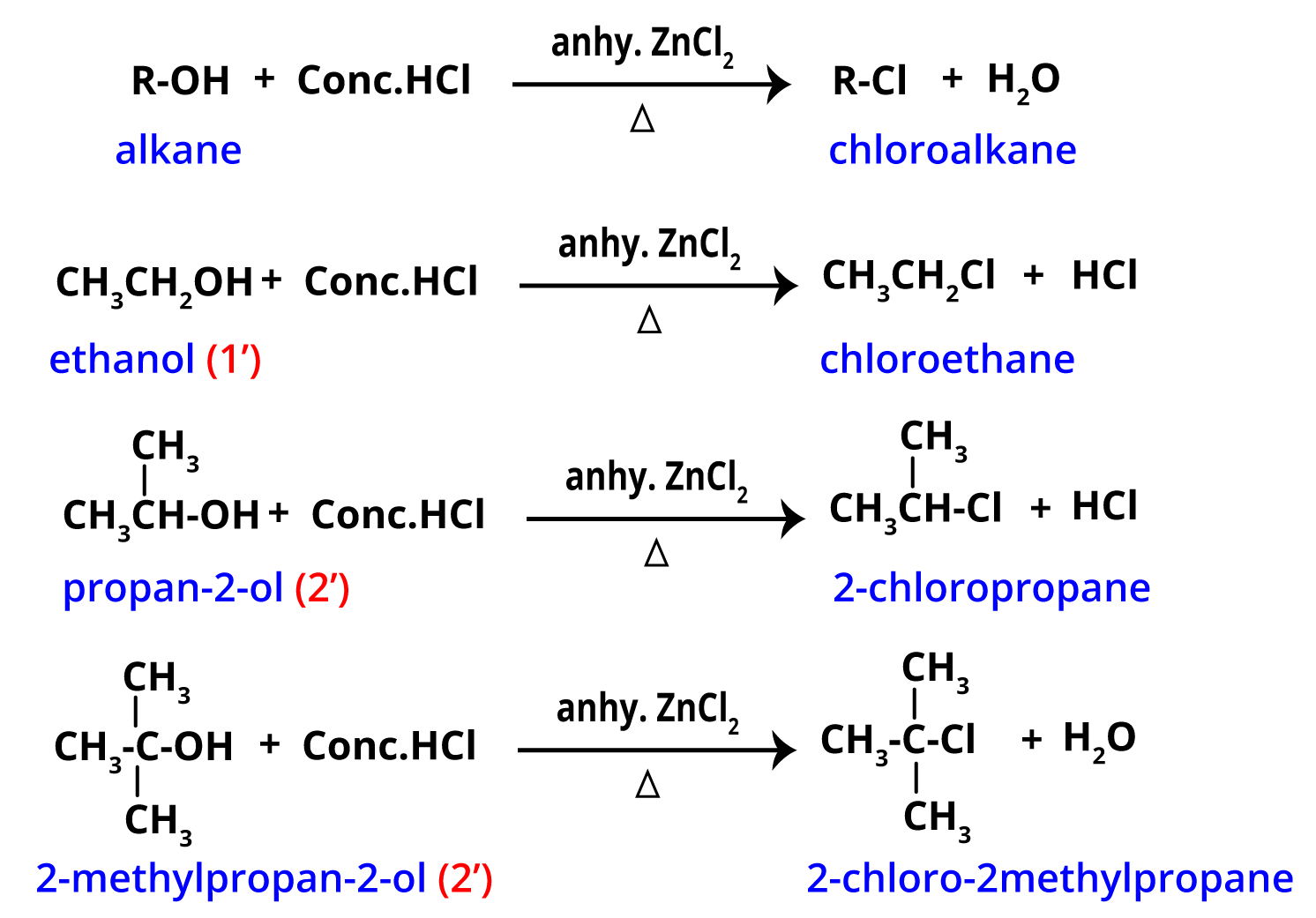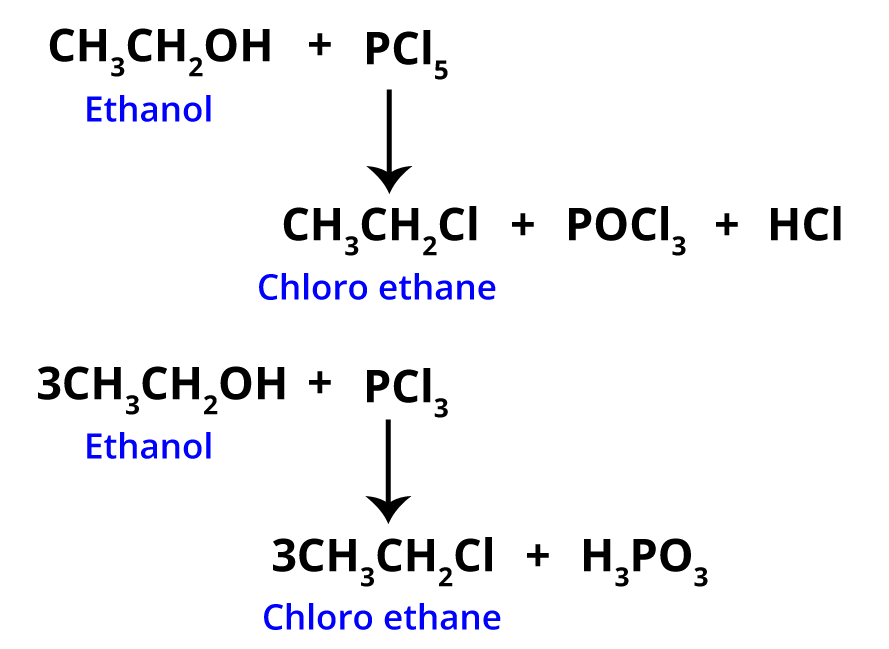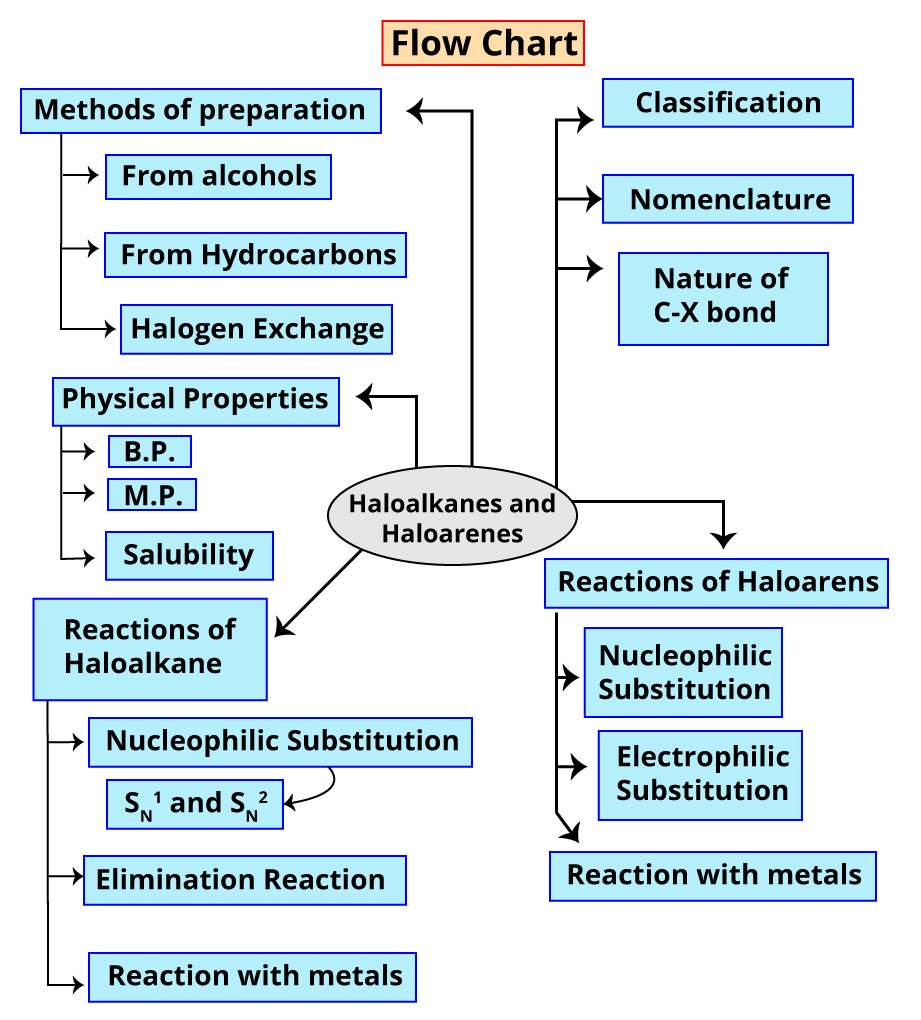




Haloalkane and Haloarene
Haloalkanes are organic chemical compounds formed when one or more hydrogen atoms from an alkane group are replaced by a halogen group (elements of group 17 such as chlorine, bromine, fluorine, iodine, etc.).
Haloalkanes are saturated organic compounds in which all of the chemical bonds are single bonds to the carbon atom and the halogen atom is attached to a single carbon atom. When a hydrogen atom in an aromatic hydrocarbon is replaced by a halogen atom, the resulting compound is known as haloarene. It is also referred to as aryl halide or halogenoarene. The primary distinction between haloalkanes and haloarenes is that haloalkanes are formed from open-chain hydrocarbons (alkanes), whereas haloarenes are formed from aromatic hydrocarbons.
Methods of Preparation of Haloalkanes from Alcohols
The easiest and most feasible method of preparing haloalkanes is from alcohol by substituting the -OH group by the halogen -X. There are different methods by which alcohol can be converted into haloalkane.
A. By Reaction with Halogen Acids
The main product of an organic compound derivative of alcohol reacting with halogen acid (H-X) is haloalkanes. For example, preparation of chloroalkane: when alcohol reacts with hydrochloric acid in the presence of anhydrous zinc chloride which acts as the catalyst, chloroalkane is formed (ZnCl2 with con. HCl is called the lucas reagent). Primary and secondary alcohols require catalysts. Since tertiary alcohol is more reactive and readily reacts with con.HCl, they do not require the catalyst.

Methods of Preparation of Haloalkane from Alcohol By Reaction with Halogen Acids
When alcohol reacts with HBr (hydrogen bromide), we get bromoalkane. The HBr here is prepared by reacting NaBr / KBr with sulphuric acid. Similarly, iodoalkane is prepared by reacting hydroiodic acid (HI) with alcohol, to produce HI. In action, 95% phosphoric acid on sodium or potassium iodide is conducted.
B. By Reaction with Phosphorus Halides
The second method of converting alcohol to haloalkane is by reacting the alcohol with phosphorus trihalides. All the haloalkanes such as chloroalkanes, bromoalkanes, and iodoalkanes can be synthesised using this method.
Chloroalkane is prepared by reacting PCl3 with alcohol. Since PBr3 and PI3 are unstable, they are freshly prepared by reacting red phosphorus with bromine or iodine. Phosphorus pentachloride when reacted with alcohol also generates haloalkane. For example, when ethanol reacts with PCl5, chloroethane is formed.

Methods of Preparation of Haloalkane from Alcohol By Reaction with Phosphorus Halides
C. By Reaction with Thionyl Chloride
Alcohol reacts with thionyl chloride(SOCl2), also forming chloroalkane. For the preparation of chloroalkane, this method is preferred more because both the byproducts escape leaving behind only the chloroalkane.

Methods of Preparation of Haloalkane from Alcohol By Reaction with Thionyl Chloride
Reaction of Haloalkane and Haloarene
Let’s now discuss the reaction of haloalkanes and haloarenes. In a haloalkane, an sp3 hybridised carbon is bonded to the electronegative halogen. Such a compound undergoes two kinds of reaction - one in which the electronegative halogen is substituted by another atom or group (nucleophilic substitution) and another in which the electronegative halogen is eliminated with a hydrogen from the adjacent carbon (elimination).
Nucleophilic substitution is a substitution reaction in which the attacking reagent is a nucleophile. It is a reaction in which a stronger nucleophile displaces a weaker one. Haloalkanes undergo nucleophilic substitutions because the greater electronegativity of halogens (X) makes the carbon-halogen bond polar.
Substitution of halogen by hydroxyl group is done by the action of aqueous alkali or moist silver oxide leading to the formation of alcohol.
Substitution of halogen by alkoxy group is done by the action of sodium or potassium alkoxide or dry silver oxide leading to the formation of ether.
Substitution of halogen by cyano group is done by the action of alcoholic potassium cyanide leading to formation of alkyl cyanides.
Substitution of halogen by isocyanide group is action of alcoholic silver cyanide leading to the formation of alkyl isocyanide.
Substitution of halogen by nitro groupies done by the action of alcoholic silver nitrite leading to the formation of nitroalkane.
Substitution of halogen by the amino group is done by the action of alcoholic ammonia leading to the formation of amines.
Elimination reaction is one in which the substrate molecule loses two atoms or groups from the same carbon atom or from adjacent carbon atoms under the influence of an attacking reagent. An example of an elimination reaction in haloalkane is dehydrohalogenation of haloalkane. Reactions of haloarene: haloarene undergoes nucleophilic aromatic substitution reaction and electrophilic aromatic substitution reaction. The reactions are shown in the haloalkanes and haloarenes flowchart given below.

Haloalkanes and Haloarenes Flow Chart
Conclusion
There are various methods of preparation of haloalkanes. The most convenient way to prepare haloalkane is from alcohol. When R-OH reacts with the appropriate reagents, the reaction produces R X. Concentrated halogen acids (HX), phosphorus halides (PX3 or PX5), and thionyl chloride are suitable reagents that aid in the reaction (SOCl2). The other methods of preparation are from hydrocarbon and halogen exchange methods. However, in this article, we mainly focused on preparation from alcohol.
FAQs on Preparation of Haloalkane from Alcohol for JEE
1. What do you understand about the nucleophilic substitution reaction?
The term "nucleophilic substitution reaction" refers to a type of organic reaction in which one nucleophile replaces another. It is very similar to the typical displacement reactions seen in Chemistry, in which a more reactive element replaces a less reactive element in its salt solution. The group that accepts an electron pair and is displaced from carbon is known as the "leaving group," and the molecule on which substitution occurs is known as the "substrate." The leaving group is either a neutral molecule or an anion.
2. Describe the ease at which Alcohol to haloalkane in presence of anhydrous ZnCl2.
The reaction is carried out either by passing the dry HX gas into the alcohol or by the alcohol with concentrated aqueous acid. The use of a dehydrating agent like anhydrous zinc chloride or concentrated sulphuric acid is sometimes used to facilitate the reaction, particularly when HCl is used.
The reaction of HCl requires the presence of anhydrous ZnCl2,.HBr and HI may also be prepared in situ by using (NaBr+conc.H2SO4) and (KI+95% H3PO4), respectively. Primary and secondary alcohols generally require heating, whereas tertiary alcohols may even react at room temperature.










